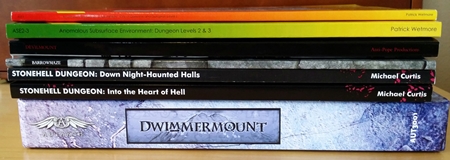I love megadungeons. I’ve often thought it’d be fun to design one, but balked because I’m not sure I have the chops and because of the sheer size of the undertaking. The solution to the first part of that problem is to just try it, but what about the second, the fact that it’s a big project?

Cue Patrick Wetmore, who designed one of my all-time favorite megadungeons, Anomalous Subsurface Environment, on keying the first level of ASE:
So I’ve got 100 rooms to key for the dungeon. Following the distribution in the back of the Moldvay Basic rules, that breaks out as follows:
1/6 monster w/ treasure = 16-17 rooms
1/6 monster, no treasure = 16-17 rooms
1/18 trap with treasure = 5-6 rooms
1/9 trap, no treasure = 11 rooms
1/6 special = 16-17 rooms
1/18 unguarded treasure = 5-6 rooms
5/18 empty = 28 roomsThat’s 17 traps, and 17 specials. That’s where all the real work lies. Sticking a bunch of monsters in a room is easy, it’s the creative bits with traps and specials that’s hard.
And bam, just like that I realized I could design a megadungeon. I read that post yesterday, and I started designing one last night.
It’s that last part, about focusing on just a third of the rooms — the special, weird rooms — that clicked for me. Seeing the whole chart from the B/X Expert Set (paid link; my favorite version of D&D) broken out into rooms in need of keying helped, too. It’s a classic “eating the whole elephant” situation, and I’d never thought of it that way.

Keep in mind also that there are roughly a bizmillion books/supplements/websites out there with that kind of material. You don’t have to make it up so much as compile a blob of sufficient size then pluck a handful blindly from that amorphous mass, use the best fit that you like the best and toss the rest back in the pile.
True, there’s plenty of inspiration out there.
I’m good with random generators and stuff to provide the seed, but making up the thing that winds up in the book seems like the fun part.
Been thinking on this on the way home and I think I disagree but in a good way:
Traps: are pretty standard actually. There’s only a handful of forms. Stuff thrown at you, swung at you, dropped on you, you dropped in it, etc… there are more i’m sure but you get the picture. They’re either natural (sinkhole, cave in) or crafted by current or old dungeon inhabitants, which informs flavor and difficulty (goblin pit traps are easier to see and climb out of than dwarven but goblin ones may have offal on the bottom) the fantastic magical ones (your demon face with the portal to entropy in the mouth, your portal to hell) are not actually traps so much as specials so you’re really only doing 17 rooms. Basic traps are no harder than monsters.
Preach it! I agree, the special rooms present the bigger challenge. Those have to be on point; the pressure feels greater than it does on the traps.